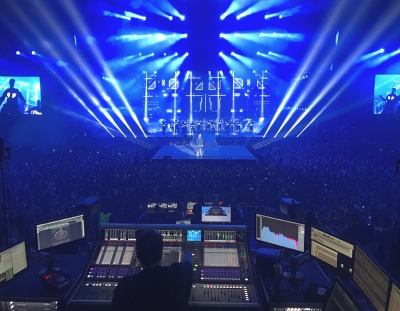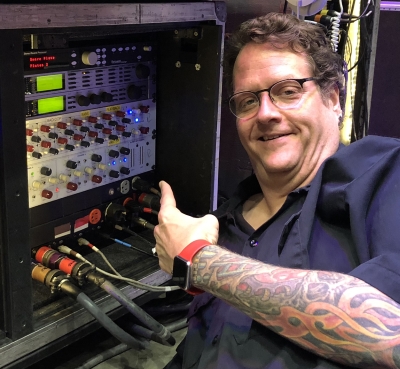
Another constant is where the vocal sits in the mix: “If you take a survey of people who go to shows – not musicians, but people who don’t know anything about mixing – 10 out of 10 will tell you the reason the show sounded great was that they heard and understood the vocal the entire time, including between songs. They’ll say, ‘Your mix was great. It had a lot of impact,’ but I know what they’re really saying is that they heard the vocal all the time.
“Average people at a show don’t care how the snare drum sounds, but what they do care about is understanding everything the vocalist says. It’s so much of a focus for me that I start line check with vocals. I think it’s hilarious that everyone starts with the kick and sits there and tweaks for 30 seconds, two minutes, five minutes… Get the vocal right in the PA first and then all of the other stuff will lie in there.”
Evolving The Approach
Given recent advancements in pro audio technology, loudspeakers in particular, Van Druten believes there’s no excuse for a bad-sounding show: “All of the tools exist for every seat in an arena or stadium to sound good. It’s how you deploy them.”
That said, he believes that heavy dependence on technology is akin to bringing a gun to a knife fight. “One reason I see engineers fail is they’re using too much technology; trying desperately to use 22 plugins on something, or whatever. Less is always more.”

He describes himself as someone who sticks to what he knows – a creature of habit. For the past five years, barring some outboard gear that he swaps in for specific gigs, that means a Waves-enabled DiGiCo SD7 console at front of house.
“Every couple of years I’ll adopt a new technology, partly because I feel like I’m getting my butt kicked by a younger kid who maybe adopted that technology right off the bat,” he notes. “But I have a number of front of house buddies, so when something comes out, one of them tries it and says ‘this is cool’ and then, grudgingly, I’ll try it and be like, ‘OK, this helped me,’ or ‘This didn’t help and I’m never using it again.’”
He adds that as the pace of change ramps up, he’s become more open to trying new gear early on. But it still needs to work within his style and aesthetic rather than something being touted as the “latest and greatest,” and he points to his use of Waves plugins as a good example.
“I first got involved with Waves while mixing Linkin Park in 2007,” he says. “My Avid VENUE console was new, and I was using plugins from other manufacturers for the first six months and getting good results. But then I met someone from Waves who gave me the opportunity to try their stuff, and within the next week I replaced 95 percent of what I was using before and ended up with a significantly better result.”
Ten years on, Van Druten’s relationship with Waves is still going strong. Over that time he’s developed plugins for the company and has recently been test-driving the eMotion LV1 mixer that dispenses with a hardware surface in favor of touch screens. It’s a viable solution, but he adds, “Most of the gigs I do these days are 120 inputs-plus. Managing that using a console that’s all touchscreen, I think, would be difficult.”
However, for lower input counts, he states that, “It would be my go-to. First, it sounds great. It does take a bit of getting used to – riding a vocal on a touch screen is different than having a tactile fader – but like any other platform, you learn how to use it, and I’ve mixed gigs with it and adopted a workflow very quickly.”
Future Vision
The willingness to adapt, along with ensuring that the person with the microphone isn’t being greeted by “What’d he say?” and the proper care and feeding of diverse audience expectations are all part of Van Druten’s success. So, too, are people skills.
“I think that’s been a large part of my success, and I tell kids starting out in this industry to learn how to interact with people,” he says. “If you can walk into a room and instantly gauge other people’s perception of what’s happening, then you’re over and above in being able to communicate with them.
“And let’s be honest: musicians are surrounded by people who tell them what they want to hear. For big artists who’ve been doing this for a while, it’s refreshing for them when you tell the truth. Now that only works if you’re really telling the truth and they’re asking for your opinion. It’s not like I walk up and say, ‘Hey, that sucks.’ If you’re the person who walks in and says, ‘I don’t like that part – just my opinion – but I think that it would be better if…’ they’ll respect you, and your relationship is then based around trust.”
Another bit of advice he offers to those just starting out: Regardless of how dedicated you are, how badly you want to work in audio, and how complete your education is, few people actually end up working long-term in live sound.
“I get mad at schools that promise every person in their program that they’re going to have a job placement after graduation,” he continues. “When I speak at Berklee and Full Sail [University], I tell students that it’s not good enough to graduate. You have to live, eat and breathe everything about live sound and be better than every other kid in your class, and then maybe, just maybe, a live sound company will hire you to hump cable for a year. Not everyone gets jobs.
“I’m definitely aware of the opportunities that I’ve been given and I’m blessed to be in the situation that I am,” Van Druten concludes. “And I think it’s absolutely my responsibility to pass on any knowledge that I have to anybody who’ll listen. Everything that I utilize in my workflow today I learned from someone else. I watched another engineer do something that worked and adopted it, or I learned from something they did that didn’t work.
“I really enjoy being in a room with 50 people, and as I’m talking about something super-technical, I can see in the eyes of two people – two out of the 50 – that they really get it. And you know that those two are probably going to be the ones that you’ll be competing with for jobs.”
